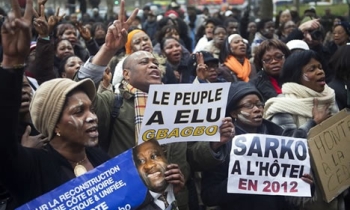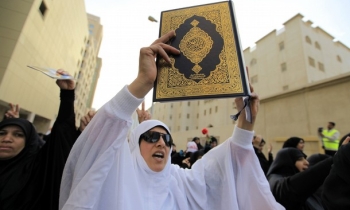Less than a year ago, Gary B. Pruitt, the head of the McClatchy Company, was hailed as the white knight of newspapers. While others saw the industry headed for the dinosaur graveyard, Mr. Pruitt rode in to buy the Knight Ridder papers, or some of them anyway.
Although he was the only bidder, he pronounced the industry very much alive. BusinessWeek said Mr. Pruitt was “widely considered the best in the business.”
Since then, Mr. Pruitt seems to have lost his long-held place as the darling of the industry and of Wall Street. Since McClatchy bought Knight Ridder last March, the company has performed worse than most of its peers. Last week, its stock price hit a 52-week low, $37.82.
In December, Mr. Pruitt made a move that sent shock waves through the industry, dumping The Minneapolis Star Tribune, the biggest paper in the McClatchy chain. Not just that, but he sold it for $530 million — less than half of what he paid for it eight years before.
The sale sent a clear signal that some of the industry’s premier properties were eroding in value. Apart from its own woes, McClatchy’s sale of The Star Tribune could not have come at a worse time for the Tribune Company, which has been on the auction block since last fall.
In the convoluted bidding thus far, Tribune has received only two firm offers — a jerry-rigged bid from two Los Angeles billionaires, Eli Broad and Ronald Burkle, and another from the Chandler family, Tribune’s largest shareholders. (A third, from the Carlyle Group, is just for Tribune’s two-dozen television stations, not its 11 newspapers, which include The Los Angeles Times and The Chicago Tribune, or its baseball team, the Chicago Cubs.)
The downturn at The Minneapolis Star Tribune, where advertising revenue had plunged by 6 percent in November compared with the year earlier, has not been the only danger sign of an industry on the rocks. Ad revenue for many papers fell sharply over the summer, and publishers do not see a recovery for at least the first half of this year.
The Boston Globe, owned by The New York Times Company, and The Philadelphia Inquirer, now privately owned, are only the latest to make deep cuts in their newsrooms (including the outsourcing of about 55 support jobs at The Globe to India).
Less than two weeks ago, the Times Company, which also owns The Worcester Telegram & Gazette, took a $814 million write-down on its two New England papers, saying they are worth only about 40 percent of the $1.4 billion that the Times Company originally paid for them.
Against this backdrop, is it any wonder that bids for Tribune have been scarce? Or that no newspaper company has made an offer?
“It’s instructive that the billionaires floating around in L.A. and Boston who have expressed interest in some of these papers are all unsophisticated about the newspaper business,” said John Morton, an industry analyst. “They don’t know what’s going on.”
He added that the Minneapolis sale had tarnished Mr. Pruitt’s reputation in newsrooms.
“If you had this warm and fuzzy feeling about being taken over by McClatchy, I suspect that has dissipated,” he said. “As a financial steward, you couldn’t get anybody to run your company better than Gary Pruitt, but you can’t look at everything from a financial steward point of view. For heaven’s sake, newspapers are a public trust. He’s acting as if he’s running a green bean cannery.”
Mr. Pruitt himself says he remains confident about the future of newspapers, “both in print and online,” and defends the sale of The Star Tribune. It provided a big tax benefit for McClatchy, he said, and the company is using the proceeds to help pay off the $2 billion debt it incurred in buying Knight Ridder.
“I never thought of us as the white knight,” Mr. Pruitt said of the Knight Ridder purchase. “I thought of us in more prosaic terms — it was an opportunity to make an attractive acquisition on our terms, to strengthen the company long-term.”
Selling the Minneapolis paper, he said, was also a move for the long term.
“Sometimes that means you’re popular and sometimes that means you’re unpopular, but that’s not part of the criteria,” he said. “This is not high school.”
Alexia Quadrani, a media analyst at Bear Stearns, said there was some concern among newspaper owners that they were not given a chance to bid for The Star Tribune before it was bought by Avista Capital Partners, a private equity firm.
“This property wasn’t shopped around,” she said, suggesting that perhaps newspaper companies might have paid more than Avista Capital did.
Mr. Pruitt has not described his sale process, saying only that he “took soundings” among media companies and thought he would be able to do a deal more quickly with private equity. “We weren’t trying to get a low price,” he said. “That criticism is misplaced.”
Apart from what happens to The Star Tribune in the hands of Avista Capital, analysts agreed that the sale could help McClatchy financially in the long run.
“I recommend a buy on McClatchy,” said Barry L. Lucas, an investment analyst at Gabelli & Company, in Rye, N.Y. “You will see revenue growth come back, you will see debt come down rapidly, and ultimately, Gary may be proved right.”
It is not clear what role the sale of the Minneapolis paper may have played in the minds of bidders or potential bidders for Tribune, which has said it will lay out its strategy for the future by the end of March. Analysts said it was difficult to isolate the Minneapolis price as a factor in the Tribune auction, given the state of the industry.
“People certainly took notice,” said James M. Walden, a stock analyst with Morningstar. “And it highlights what the industry is going through in the larger markets.”
But, he said, there are so many other considerations with Tribune, including that the company said it wanted to sell itself in one piece, not broken up. And analysts point out that the price of the Minneapolis paper plays little role in a bidder’s more important calculations, like what the cash flow at Tribune would be or what the exit strategy would look like.
Brian Hamilton, chief executive of Sageworks, a financial information company based in Raleigh, N.C., said that the performance signs for Tribune are all good.
“Tribune is very profitable,” he said. “It’s rare that I see a company in any sector as profitable as this one is.” He said Tribune’s profit margins over the last six years ranged from 18 percent to 22 percent, compared with an average margin of 6 percent for all publicly traded companies in that period.
But the price for The Star Tribune, and the recent write-down by the Times Company of The Globe, can complicate the process of setting a value for Tribune, analysts said, both as a whole and for its individual assets.
“Clearly, we’ve lost half the value of newspaper companies in two years,” said Ken Doctor, the lead analyst for Outsell, a market research and consultant company for the information industry. Their most important task now, he said, is to figure out how to make enough money online to make up for what they are losing in advertising revenue in their print editions.
“No one in the industry has got it figured out,” he said. “And Minneapolis was just one further warning sign. It was one more data point, and it’s hard to find positive data points that turn around the economic projection.”









